Art Lovers discussion
Questions from the Met
 Smoke is associated with so many conflicting meanings: ill health, industrial progress, pollution, rebelliousness. What meanings do you associate with smoke?
Smoke is associated with so many conflicting meanings: ill health, industrial progress, pollution, rebelliousness. What meanings do you associate with smoke?Modern and contemporary art curator Ian Alteveer contemplates the good and the bad associations of smoke.


http://sensitivelight.com/smoke2/
[image error]
[image error]
I think it's mesmerizing!
Smoke Art: Images created by combining thousands of pictures of smoke to form incredible works of art
http://www.telegraph.co.uk/culture/cu...
 Heather wrote: "I have often greatly admired the sculptural works of artists such as Michelangelo, Rodin, Bernini just to name a few.
Heather wrote: "I have often greatly admired the sculptural works of artists such as Michelangelo, Rodin, Bernini just to name a few. I mean, check out Apollo and Daphne by Gian Lorenzo Bernini.
I agree with you. I am amazed at what they could envision in a raw chunk of stone...such awesome detail...Wow!
The detai..."
 "Is a broken or incomplete work of art frustrating to look at or does its “imperfect” state make it more exciting"?
"Is a broken or incomplete work of art frustrating to look at or does its “imperfect” state make it more exciting"? Islamic art curator Navina Haidar extols the implications and aesthetics of the broken or incomplete.
 Heather wrote: ""Is a broken or incomplete work of art frustrating to look at or does its “imperfect” state make it more exciting"?
Heather wrote: ""Is a broken or incomplete work of art frustrating to look at or does its “imperfect” state make it more exciting"? Islamic art curator Navina Haidar extols the implications and aesthetics of the..."
Boy that's a tough one. I think you could talk forever about that. Both.
Well, hmmmm, seems like the classicists sought to recreate and complete the "perfected" forms they found or dreamed they found in antique statuary and ruins, and the romanticists found charm in ruins and desolation, of beauty injured and roughed up. I think part of the idea was kicked off by the Romantics: the Venus de Milo is doing great without arms. As the human record stretches out in time, artifacts undergo many interesting transformations that alter the original intent of the work. Statuary breaks. Oils become brittle over time and more transparent, many varnishes become murky, and some colors are unstable and transform the appearance. Rembrandt's paintings were much more colorful or contained more contrast then after they aged in syrupy brown varnishes. After a while, as the varnish aged the "look" of old varnish became sought after. In many cases a cherished glaze effect, thought to be a secret of an old master turns out to be due to the increased transparency, a sketchier look is observed, due to pentimenti in the underpainting. A more sophisticated way is to deliberately value such an effect by allowing prior lines and underpainting to show through. Degas was one of the first to deliberately show his pentimenti. If you ever get a chance to see Guernica look at how Picasso used overpainting showing the visible pentimenti to enrich the surfaces of his somber theme and palette.
When I look at an older work of art, I try to imagine it with a kind of double vision, both its condition and it's original state or intent, much like the memory of a first date with an old lover.
If a work is so damaged this double experiencing of the work is impossible in its dilapidated condition, then it may be of historical or art historical importance but the aesthetic experience may have flown. I am referring to where some kind of dialog with the work and time is possible.
On the other hand, a work may sustain significant damage and still have great charm.
Oddly our muscles for such an imaginative exercise seem to be stronger the farther back and more remote an object is. Even when it comes from a remote time
and culture, we try harder, it seems, and we tolerate more damage.
If we imagine two statues, say, of equal aesthetic merit, each one damaged with the head and arm lost forever, but posit one is new and was nearly destroyed shipping between museums this month, and one is ancient and recently unearthed in Greece, our emotional reactions, and our sense that the work is "ruined" may be quite different!
The exposure to time and the exposure of the elements of technique through damage allow us to see a kind of distressed beauty, which is one of the sources of the modern aesthetic.
That's my two cents worth....
 It's "imperfect state" certainly stirs the imagination. You could build in your mind what you think the complete image would be or wonder how and why or if it was damaged. Was its imcompleteness part of the initial design? I can see that it could be frustrating, if the image was particularly enticing for you, but there wasn't any more to enjoy.
It's "imperfect state" certainly stirs the imagination. You could build in your mind what you think the complete image would be or wonder how and why or if it was damaged. Was its imcompleteness part of the initial design? I can see that it could be frustrating, if the image was particularly enticing for you, but there wasn't any more to enjoy.
 Imperfect was the complaint about the Impressionist paintings when they were beginning. In the case of that style of painting, enough is given so that you are able to fill in the missing detail for yourself. I have no problem with that kind of imperfection, in fact, I quite like it.
Imperfect was the complaint about the Impressionist paintings when they were beginning. In the case of that style of painting, enough is given so that you are able to fill in the missing detail for yourself. I have no problem with that kind of imperfection, in fact, I quite like it.
 Great comments you guys. I was thinking something similar, but my post was getting too long.
Great comments you guys. I was thinking something similar, but my post was getting too long.The observer completes the work (even if it is in your drawer and you are playing observer). (In my own painting I try to make things "read" multiple ways.) In imagery (even in abstract stuff there is reference) this leads off to a trail of associations. In spatial conventions, this leads to motion, as one way of "reading" the space swaps with another. In drawing, graphics, or in painting that shows multiple states, an observer can construct an imaginary line which is a synthesis of all the actual ones.
 Do you think that the ladder in Rauschenberg’s “Winter Pool” transforms the piece, as great art should do?
Do you think that the ladder in Rauschenberg’s “Winter Pool” transforms the piece, as great art should do?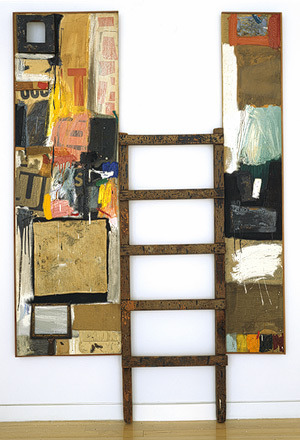
Winter Pool, 1959
Robert Rauschenberg (American, 1925–2008)
Combine painting: oil, paper, fabric, wood, metal, sandpaper, tape, printed paper, printed reproductions, handheld bellows, and found painting, on two canvases, with ladder
Source: Robert Rauschenberg: Winter Pool (2005.390) | Heilbrunn Timeline of Art History | The Metropolitan Museum of Art
 Transforms? Ladders as art. Sure. IMO Rauchenberg could do no wrong. Saw some of his pieces in a gallery in Miami. One multi level plexi box I'd love to own. Where's $19,000.00 when you need it?
Transforms? Ladders as art. Sure. IMO Rauchenberg could do no wrong. Saw some of his pieces in a gallery in Miami. One multi level plexi box I'd love to own. Where's $19,000.00 when you need it?
 Do you notice more details in a work of art at a museum when you admire it silently or when you share your thoughts about it with others?
Do you notice more details in a work of art at a museum when you admire it silently or when you share your thoughts about it with others?Textiles conservator Cristina Carr observes the minute details that fill works of art with a whole new life.
Have you ever “zeroed in” on the details in a work of art? What did you see on closer inspection?
Is there an experience you would like to share?
 Monica wrote: "Transforms? Ladders as art. Sure. IMO Rauchenberg could do no wrong. Saw some of his pieces in a gallery in Miami. One multi level plexi box I'd love to own. Where's $19,000.00 when you need it?"
Monica wrote: "Transforms? Ladders as art. Sure. IMO Rauchenberg could do no wrong. Saw some of his pieces in a gallery in Miami. One multi level plexi box I'd love to own. Where's $19,000.00 when you need it?"Hey, here's a page with a large image of this painting, and some details.
 Ed wrote: "Great comments you guys. I was thinking something similar, but my post was getting too long.
Ed wrote: "Great comments you guys. I was thinking something similar, but my post was getting too long.The observer completes the work (even if it is in your drawer and you are playing observer). (In my o..."
My first thoughts were about the Japanese wabi-sabi belief in the beauty of imperfection! I love the fact that the imperfection of a tea bowl is revered as much as it's perfection. I collect tea bowls (chawan) and love that aspect of them.
http://www.touchingstone.com/TeaBowls...

 Details in a work of art . . .
Details in a work of art . . .As much as I enjoy spending time with an artwork alone in an intimate way, discovering things. I have to say that closely examining an artwork with a diverse group of people (who will verbally contribute their ideas & be respectful) is where I can see so much more, for example, in the same artwork. It makes me look at the painting through their eyes and, hopefully, understand their interpretation. I couldn't see that without them.
I feel that seeing an artwork alone & with a group are equally important.
 I think that for the most part I like the encounter alone, maybe a little naked (metaphorically speaking, I never streak at art exhibits). I don't mind other people around, though I frequently run into them backing up to see a painting (especially in crowded openings).
I think that for the most part I like the encounter alone, maybe a little naked (metaphorically speaking, I never streak at art exhibits). I don't mind other people around, though I frequently run into them backing up to see a painting (especially in crowded openings).I do like sharing what I see with another person, especially if I can get them to see a new aspect of art.
There is a little suspension of everything that I like to go into, make my mind blank of preconceptions for a second and see what immediately comes to me from the work, after which I may become involved and explore it, or analyze it.
 Are there depictions of mothers in works of art to whom you can relate?
Are there depictions of mothers in works of art to whom you can relate?How do you feel when you see an "idealized" mother represented in a work of art? Reassured? Frustrated? A mixture of many emotions?
Lecturer Jean Sorabella finds inspiration in idealized depictions of mothers.
 I think Mary Cassatt epitomizes motherhood in her work. The following are some of my favorites.
I think Mary Cassatt epitomizes motherhood in her work. The following are some of my favorites.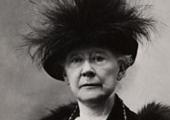
Mary Cassatt
Style: American Impressionism, Impressionism
Lived: May 23, 1845 - June 14, 1926 (19th - 20th century)
Nationality: USA
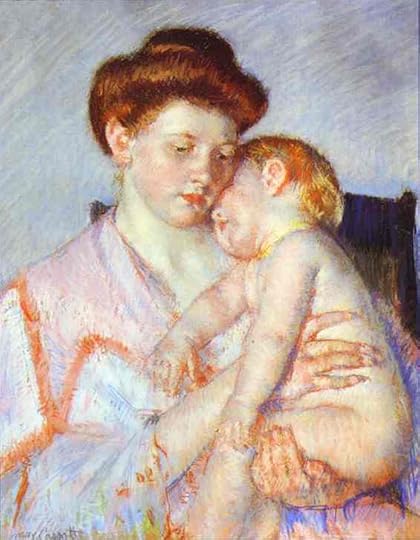
Sleepy Baby
1910
by Mary Cassatt
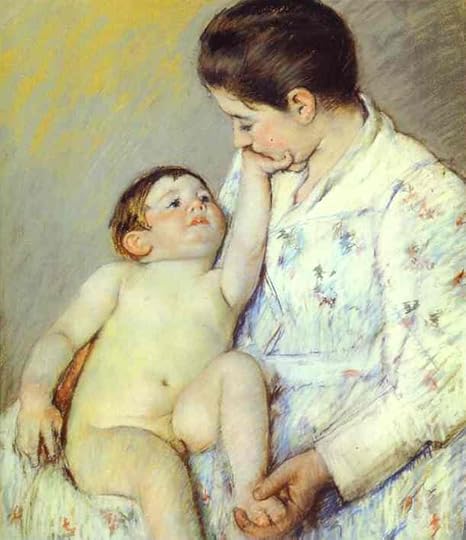
Baby's First Caress
1890
by Mary Cassatt
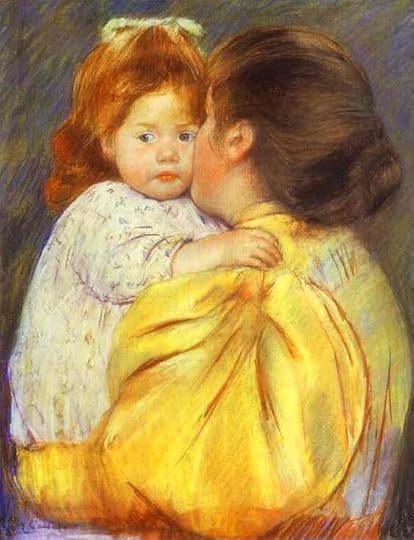
Maternal Kiss
1897
by Mary Cassatt
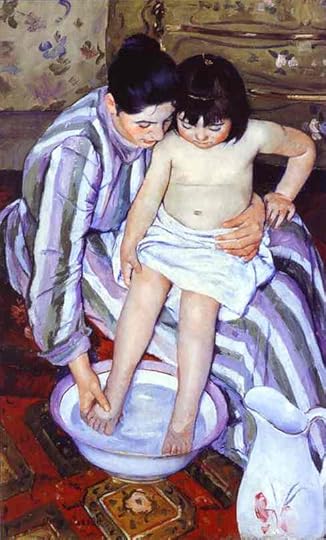
The Bath
1893
by Mary Cassatt
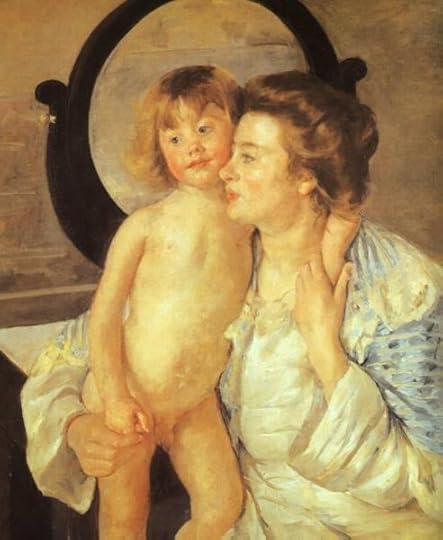
The Oval Mirror
1901
by Mary Cassatt
I don't have any children of my own, but sometimes when I see this art, I think of my own mother. I can't even imagine what mothers go through to raise their children. It must be both frustrating and very satisfying.
 It is. Even all the frustrations you go through as a parent are worth it. The tired nights etc. You look back on those days with joy/satisfaction.
It is. Even all the frustrations you go through as a parent are worth it. The tired nights etc. You look back on those days with joy/satisfaction. I like these pictures. You can actually feel what they are feeling in the picture....you can see the joy, care, etc...
 Is it troublesome when one has to explain the beauty of a work of art? That a work which requires a long explanation is, in some way, lacking?
Is it troublesome when one has to explain the beauty of a work of art? That a work which requires a long explanation is, in some way, lacking?Intern Diana Greenwald and curator of drawings and prints George Goldner discuss where taste comes into play with Museum acquisitions.
How do you define “tasteful” art? Must it stand the test of time?
 Heather wrote: "Is black the absence of color or is it full of color? Which work of art best supports your view?
Heather wrote: "Is black the absence of color or is it full of color? Which work of art best supports your view?Aimee Dixon"
This is a question that was posed in January and created a good discussion. It begins with post #14.
I found this quote by Leonardo da Vince which I thought was interesting and applied here. Just a 'gee whiz'.
"A painter should begin every canvas with a wash of black, because all things in nature are dark except where exposed by the light."
— Leonardo da Vinci
 Interesting. I cannot paint on a white canvas. For me, it is too overwhelming. So instead I paint the whole canvas in cobalt blue, and after it dries I have no problem painting.
Interesting. I cannot paint on a white canvas. For me, it is too overwhelming. So instead I paint the whole canvas in cobalt blue, and after it dries I have no problem painting.
 Post #50 Ed wrote: "As a rather subversive exercise, let me include a particular work (Don't peek at the image URL). And the question is--not is this the finest piece of art that you have ever seen-- nor, is this the finest piece of art that you have ever seen-- nor, is this your favorite style. It is simply, is this art?..."
Post #50 Ed wrote: "As a rather subversive exercise, let me include a particular work (Don't peek at the image URL). And the question is--not is this the finest piece of art that you have ever seen-- nor, is this the finest piece of art that you have ever seen-- nor, is this your favorite style. It is simply, is this art?..."Work of art or child's scrawl: Which one is which?
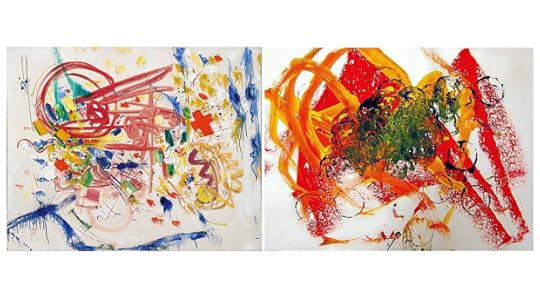
Deborah Mensah-Bonsu
Globe and Mail
A single line thrown onto a canvas. Simple blocks of colour. A clutter of squiggles. Should you be sauntering past the wall of abstracts at a museum this summer, a cynical thought may swiftly follow: “My kid could have done that. Heck, a monkey could've done that.”
Well it turns out that your kid and your monkey can't do that.
To test whether people really mistake paintings by professionals with those produced by children and chimps, researchers at Boston College showed art and non-art students pairs of images – one by an Abstract Expressionist (including images by Mark Rothko, Charles Seliger, Clyfford Still, Sam Francis, Hans Hofmann, and Cy Twombly), and one by a child or animal. Their survey results, released in March, revealed that a clear majority of participants in both groups liked the professional paintings more and judged them as better.
“We are showing that the disparaging things people say don’t hold up,” says Ellen Winner, chair of the Department of Psychology at Boston College and co-author of the study Seeing the Mind Behind the Art. “A child could not have painted a Twombly … even the untrained eye can see the difference.”
Forty non-art students and 32 art students participated in the study. Winner and PhD candidate Angelina Hawley-Dolan selected 30 paintings by abstract expressionists, and paired each painting with a similar work by a child or animal (monkey, gorilla, chimpanzee or elephant). They flattened both images on a computer screen and made them as similar as possible in terms of size and resolution.
Both groups saw the first 10 image pairs without any labels; the rest of the images were either correctly labelled or reversed. They were then asked which they liked better and why, and which was a better work of art and why. Participants preferred professional paintings and, more than 60 per cent of the time, judged them as better than the non-professional paintings even when the labels were reversed.
“A lot of people think about art as taste, sort of like ice cream – you like chocolate, I like vanilla – but there’s another component where people agree on these objective standards, specifically in Abstract Expressionism,” Hawley-Dolan says.
The study is still topical for Elizabeth Smith, executive director of curatorial affairs at the Art Gallery of Ontario. This weekend the Toronto gallery will open the exhibition Abstract Expressionist New York, on loan from Manhattan’s Museum of Modern Art, and it features the work of many of the best-known artists of the movement.
Smith isn’t surprised by the results of the Boston College study. “The quality, vigour and mastery that you see in these paintings really communicate,” she says. “When you look at a Jackson Pollock painting for more than half a second, see how the drips and strokes reveal themselves across the surface of the painting, imagine the artist and his rigorous movements … it can’t help but envelop and fascinate you.”
More than in figurative or representational art, where an object or theme is recognizable, abstract art communicates emotion, feeling and intangible elements, Smith says: “It’s more akin to the way music operates on us. It causes us to experience memories and reveries.”
Abstract art can look simple, which leaves it vulnerable to criticism, but it comes from a complex beginning. “Few people realize that artists who choose to paint abstractly are often trained classically and traditionally,” Smith says. “They feel it gives them a way to communicate differently and more powerfully with the viewer.”
Denyse Thomasos is a Canadian abstract artist living in New York. She began painting figuratively but later turned to abstraction. “It offers a kind of openness. The intention can take on all different forms; it could be journalistic, emotional or metaphoric,” Thomasos says. “I love the fact that you can just go into your studio and get started – you don’t need a model or photograph, you don’t even need an idea.”
Thomasos has worked with children, and says the freedom that comes across in their art is what makes it appealing. Professional art, however, has a purpose behind it that viewers pick up on, and can be interpreted like a language.
“When kids are working, a lot of it is coming from an urge, not so much intellectual, but a response, a reaction, and play,” she says. “An artist is making a deliberate choice for something to be here or there.… One approach with line can feel very lyrical and soothing, and then a rigid line can feel more anxious and threatening.”
Smith says the language present in the work of the Abstract Expressionists has a depth and richness that will reach even the skeptics – as long as they approach it with an open mind.
“If they look closely at each of the works, I think that their skepticism will turn into admiration,” she says. “But they need to take the time to look closely.”
Were you able to identify which of the two paintings in the photo accompanying this story was the real one?
The child's painting in the photo at the top of this story is the one on the right.
 Heather wrote: "Post #50 Ed wrote: "As a rather subversive exercise, let me include a particular work (Don't peek at the image URL). And the question is--not is this the finest piece of art that you have ever see..."
Heather wrote: "Post #50 Ed wrote: "As a rather subversive exercise, let me include a particular work (Don't peek at the image URL). And the question is--not is this the finest piece of art that you have ever see...""A budding art prodigy
June 5, 2011 3:49 PM
Aelita Andre is taking the art world by storm, and is about to have her first gallery opening in New York City - at age 4. Elaine Quijano reports.
"
Check this out. I am suspicious, but they appear to have documentation.
 "Do you notice gestures when you look at art? Do they help you to understand what you see?"
"Do you notice gestures when you look at art? Do they help you to understand what you see?"Denise Leidy
Is there a piece of art with gestures that evoke a certain emotion? Which one(s)?
 "Do you think that Jackson Pollock’s “Untitled” (ca. 1948–49) is reminiscent of the visual element in a musical score?"
"Do you think that Jackson Pollock’s “Untitled” (ca. 1948–49) is reminiscent of the visual element in a musical score?"Elizabeth Weinfield
"Does your appreciation of music have an impact on the way you look at art?"
 Sort of. The only problem with the question is that a whole darn lot of Jackson Pollock's titles are "Untitled"!
Sort of. The only problem with the question is that a whole darn lot of Jackson Pollock's titles are "Untitled"!The association I see is with the conductor's baton. The gesture is generative. In the case of Pollock, the gesture is also generative, but collapses into space.
I think that some of Klee and Kandinsky's paintings have a certain similarity to musical scores.
There are a bunch of correspondences. Pitch, has an analogy to color, as does intensity.
There are several ways in which a space art can simulate a time art, like music or dance.
The "score" of a painting can be the way the composition leads your eye around. A line can have different "speeds" it can be"fast": be straight and smooth or "slow" curved and rough.
This book has some analogies to musical theory:
Point and Line to Plane
 Heather wrote: "Post #50 Ed wrote: "As a rather subversive exercise, let me include a particular work (Don't peek at the image URL). And the question is--not is this the finest piece of art that you have ever see..."
Heather wrote: "Post #50 Ed wrote: "As a rather subversive exercise, let me include a particular work (Don't peek at the image URL). And the question is--not is this the finest piece of art that you have ever see..."Got it right-filled me with glee!
 That's great, Red!
That's great, Red!Did anyone see on the news about that 4 yr. old art prodigy? I guess she is 10 now. Her work is esteemed so good that the paintings start selling for at least $4,000-$5,000? I can't remember the whole story.
Marla Olmstead (born 2000 in Binghamton, New York) is a painter of abstract art. By the age of 4 she had attracted international media attention. Abstract artworks purportedly painted by her have been as large as five feet (1.52 m) square and have sold for tens of thousands of US dollars. A 2005 60 Minutes II story on Olmstead that first brought her publicity led to speculation that the works supposedly created by Marla were in fact created in collaboration with her father, which was further examined in the 2007 documentary on her, My Kid Could Paint That.
http://www.cbsnews.com/stories/2005/0...

Lake Marla Olmstead

Ocean Marla Olmstead
[image error]
 Heather wrote: "That's great, Red!
Heather wrote: "That's great, Red!Did anyone see on the news about that 4 yr. old art prodigy? I guess she is 10 now. Her work is esteemed so good that the paintings start selling for at least $4,000-$5,000? I c..."
Good grief, now we have two four year old painting prodigies?
It's an interesting question as to how much help makes a parent the co-author of a work of art. I did help mix colors and set them out for my kids, but I didn't ever touch the brushes to the paper.
I remember one painting in particular, with my oldest daughter. It was four feet square on white butcher paper. We had it on the lawn and she was sloshing reds and blacks on. I held her upside down so she could paint the center. Not a bad effort for a two year old. It looked sort of volcanic. Anyway, there was a children's art show, and she won a ribbon in the youngest division, at the "Art and Cookie Festival." No New York Galleries, however. :)
She's 23 now, and her "artistic career" has petered out....
 Heather wrote: ""Do you think that Jackson Pollock’s “Untitled” (ca. 1948–49) is reminiscent of the visual element in a musical score?"..."
Heather wrote: ""Do you think that Jackson Pollock’s “Untitled” (ca. 1948–49) is reminiscent of the visual element in a musical score?"..."MUSIC AND ART -- AND WEATHER!
http://cosmiclog.msnbc.msn.com/_news/...-
Nathalie Miebach decides what storms sound like.
This Boston artist spends her studio time turning reams of weather data — wind speeds, barometric readings and rainfall totals — into music and sculptures.
Miebach's work has tracked temperate storms, documented the daily weather of beaches. In one particularly poignant project, she created a musical piece that documented changes in weather during the week following her father-in-law's death. For her work, Miebach was selected as a 2011 TEDGlobal Fellow. ...
[image error]
11 years ago, a freak double-storm off the coast of Gloucester, MA, sank a shipping vessel called the Andrea Gail, a story that was captured in the film "The Perfect Storm" based on the book with the same name. This wall mount tracks the path of both storms: one in striped piano tracks at the bottom, and the other larger storm in blue at the top. The Andrea Gail is the little red boat at the top right corner of the mount.
[image error]
The musical score for "Hurricane Noel" incorporates weather data from a storm that swept through North America's east coast over the course of three and a half days in 2007.
 Heather wrote: ""Do you think that Jackson Pollock’s “Untitled” (ca. 1948–49) is reminiscent of the visual element in a musical score?"
Heather wrote: ""Do you think that Jackson Pollock’s “Untitled” (ca. 1948–49) is reminiscent of the visual element in a musical score?"Elizabeth Weinfield
"Does your appreciation of music have an impact on the..."
Another one!
Two new Phillips Collection exhibitions involve tie between abstraction and music
By Philip Kennicott, Friday, June 10, 9:00 AM
The history of abstract art might be called a century-long narrative of envy, sometimes mutual, between the brash, upstart visual form and the older, more established, seemingly more rational discipline of music. As two new exhibitions at the Phillips Collection make clear, a strange inferiority complex has spurred abstract artists to borrow and steal from music, from abstraction’s tentative origins to its current status as (mostly) vitiated decoration for the masses. The results, paradoxically, have been some embarrassing scenes, a lot of intellectual confusion and some magnificent art....
You can read the rest of the article and see four of the pieces here.
 Yeah, this again....
Yeah, this again....Did you hear about the two little boys who found themselves in a modern art gallery by mistake?-"Quick," said one, "Run ! Before they say we did it!"
 Throughout the millennia, artists have depicted the Olympian gods and goddesses in their work. Can you think of an example of a god or goddess in a work of art to whom you can relate? What characteristics in your piece make this figure particularly "real" and familiar?
Throughout the millennia, artists have depicted the Olympian gods and goddesses in their work. Can you think of an example of a god or goddess in a work of art to whom you can relate? What characteristics in your piece make this figure particularly "real" and familiar?Associate publisher Gwen Roginsky and her daughter Ana Sofia Meneses
 [image error]
[image error]Apollo and Daphne Bernini
"Apollo is in love with Daphne and Cupid wounds him with a golden arrow, which causes love and wounds Daphne, who has declared herself eternally chaste. Apollo falls in love at first sight and his love grows through his visual senses. He chases Daphne and almost overtakes her when he breathes on her hair. She pleads with her father to make her ugly so that Apollo will stop hunting her. Her father transforms her skin to bark, her hair to leaves, and her arms to branches. Her beauty remains and even in this novel form, Apollo still loves her."
"Bernini’s sculpture embodies the transformation of Daphne using touch and sight and the metamorphosis he shows is not just physical, but it is also sensual. Daphne turns her head to look back at Apollo as she begins to turn to laurel. Bernini is thus playing with the audience’s senses. Daphne’s facial expression shows her transformation is occurring. She is so afraid of being caught by Apollo, which Bernini remarkably portrays through the stone."
"The metamorphosis that Bernini shows is not just physical, but it is also very sensual."
Yes it is. I like how Bernini portrays the love/lust and almost a sense of awe in Apollo's eyes. And the tangible fear in the face of Daphne. Bernini expresses such human emotion through sculpture.
Although it is only a statue based on a myth, sometimes I wonder if an infatuation such as this could happen in life. I guess it could, but not very often because after awhile, reality sets in.
 One of my favorites!
One of my favorites![image error]
[image error]
[image error]
Interesting video . . .
http://smarthistory.org/berninis-apol...
Simon Schama also did a nice job on this piece in Power of Art.
 Carol wrote: "One of my favorites!
Carol wrote: "One of my favorites!Me too.
It does something that by all rights a statue shouldn't be able to do.
I actually posted this image on the James Joyce group. There's a chapter in Finnegans Wake where there are two old washerwomen gossiping on the backs of the Liffey, and at the end in a kind of verbal lap dissolve or morph (through words alone) they are transformed into a tree (time) and a stone (space). Similarly audacious choice of subject that by all rights would be impossible.
Interesting video . . .
http://smarthistory.org/berninis-apol...
Simon Schama also did a nice job on this piece in Power of Art."
 I think sculpture has to be the hardest art to do.
I think sculpture has to be the hardest art to do.How sculptors make their figures so real and emotive just amazes me. I still remember The Pity at the Vatican I saw in 1991 as expressing the grief of the moment as if it were yesterday.
 The Pieta is the most amazing of sculptures, and the artisans who worked on them were pure geniuses. I also like Camille Claudel's sculptures as well. And Rodin is good, too.
The Pieta is the most amazing of sculptures, and the artisans who worked on them were pure geniuses. I also like Camille Claudel's sculptures as well. And Rodin is good, too.
 Camille is my all time favorite! I read the biography of Rodin and could appreciate all the talent, skill, work and frustration that went into it...but Camille Claudel puts the sensuality into her work that Rodin seems to lack. I subsequently read Camille: The Life of Camille Claudel, Rodin's Muse and Mistress. It was excellent!
Camille is my all time favorite! I read the biography of Rodin and could appreciate all the talent, skill, work and frustration that went into it...but Camille Claudel puts the sensuality into her work that Rodin seems to lack. I subsequently read Camille: The Life of Camille Claudel, Rodin's Muse and Mistress. It was excellent!http://www.goodreads.com/book/show/64...
Books mentioned in this topic
Leaving Van Gogh (other topics)Point and Line to Plane (other topics)
Michelangelo and the Pope's Ceiling (other topics)



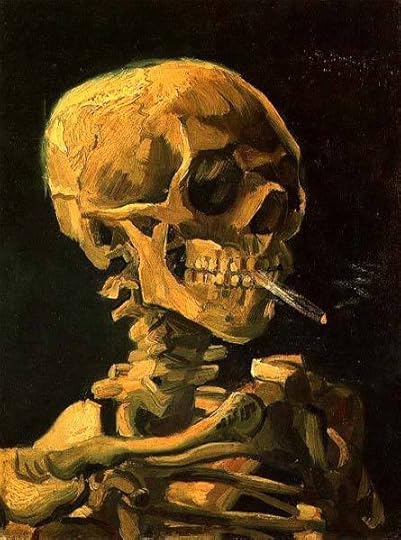



Here's a few of the images in PDF format.
I have been to the Picasso Museum in Paris. Highly recommended if you are there.....